Fabrication of Anti-Reflective Composite Structures on Inverted Pyramids Using Inductively Coupled Plasma Etching
Abstract
1. Introduction
2. Materials and Methods
2.1. Materials
2.2. Preparation of Composite Structures
3. Results and Discussion
4. Conclusions
Author Contributions
Funding
Data Availability Statement
Acknowledgments
Conflicts of Interest
References
- Pera, D.M.; Costa, I.; Serra, F.; Gaspar, G.; Lobato, K.; Serra, J.M.; Silva, J.A. Development of a metal-assisted chemical etching method to improve light-capture in monocrystalline silicon solar cells. Sol. Energy Mater. Sol. Cells 2023, 251, 112143. [Google Scholar] [CrossRef]
- Serpenguzel, A.; Inanc¸, I.; Carey, J.; Mazur, E.; Kurt, A. Luminescence of black silicon. J. Nanophotonics 2008, 2, 021770. [Google Scholar] [CrossRef]
- Fang, H.; Yu, K.J.; Gloschat, C.; Yang, Z.; Song, E.; Chiang, C.-H.; Zhao, J.; Won, S.M.; Xu, S.; Trumpis, M.; et al. Capacitively coupled arrays of multiplexed flexible silicon transistors for long-term cardiac electrophysiology. Nat. Biomed. Eng. 2017, 1, 0038. [Google Scholar] [CrossRef]
- Ban, J.; Lu, Y.; Lu, J.; Jia, K.; Luo, M.; Zhou, Y.; Wang, D.; Piao, L. Highly sensitive stretchable fiber-based temperature sensor enhanced by surface-chemically modified silver nanowires. Chem. Eng. J. 2024, 482, 148772. [Google Scholar] [CrossRef]
- Tong, L.; Wan, J.; Xiao, K.; Liu, J.; Ma, J.; Guo, X.; Zhou, L.; Chen, X.; Xia, Y.; Dai, S.; et al. Heterogeneous complementary field-effect transistors based on silicon and molybdenum disul-fide. Nat. Electron. 2023, 6, 37–44. [Google Scholar]
- Bisogni, M.G.; Del Guerra, A.; Belcari, N. Medical applications of silicon photomultipliers. Nucl. Instrum. Methods Phys. Res. Sect. A Accel. Spectrometers Detect. Assoc. Equip. 2019, 926, 118–128. [Google Scholar] [CrossRef]
- Chen, L.; Zhang, S.; Duan, Y.; Song, X.; Chang, M.; Feng, W.; Chen, Y. Silicon-containing nanomedicine and biomaterials: Materials chemistry, multi-dimensional design, and biomedical application. Chem. Soc. Rev. 2024, 53, 1167–1315. [Google Scholar] [CrossRef]
- Yeo, R.J.; Wu, W.Y.; Tomczak, N.; Ji, R.; Wang, S.; Wang, X.; Kong, J.; Liu, H.; Goh, K.E.J.; Xu, J.; et al. Tailoring surface reflectance through nanostructured materials design for energy-efficient applications. Mater. Today Chem. 2023, 30, 101593. [Google Scholar] [CrossRef]
- Almenabawy, S.; Zhang, Y.; Flood, A.; Prinja, R.; Kherani, N.P. Nanometer-mesa inverted-pyramid photonic crystals for thin silicon solar cells. ACS Appl. Energy Mater. 2022, 5, 13808–13816. [Google Scholar] [CrossRef]
- Feng, B.; Chen, W.; Xing, G.; Chen, X.; Li, H.; Sun, Z.; Zhang, Y.; Liu, Y.; Du, X. Influence of inverted pyramid texturization on front metallization and performance of crystalline silicon solar cells. Sol. Energy Mater. Sol. Cells 2024, 272, 112919. [Google Scholar] [CrossRef]
- Yu, R.; Lin, Q.; Leung, S.-F.; Fan, Z. Nanomaterials and nanostructures for efficient light absorption and photovoltaics. Nano Energy 2012, 1, 57–72. [Google Scholar] [CrossRef]
- Liu, H.; Du, Y.; Yin, X.; Bai, M.; Liu, W. Micro/nanostructures for light trapping in monocrystalline silicon solar cells. J. Na-Nomaterials 2022, 2022, 8139174. [Google Scholar] [CrossRef]
- Wang, Y.; Yang, L.; Liu, Y.; Mei, Z.; Chen, W.; Li, J.; Liang, H.; Kuznetsov, A.; Xiaolong, D. Maskless inverted pyramid texturization of silicon. Sci. Rep. 2015, 5, 10843. [Google Scholar] [CrossRef] [PubMed]
- Abdullah, M.F.; Hashim, A.M. Reflectance Characteristics of Silicon Surface Fabricated with the Arrays of Uniform Inverted Pyramid Microstructures in UV-Visible Range. Sains Malays. 2019, 48, 1163–1169. [Google Scholar] [CrossRef]
- Bernhard, C.G. Structural and functional adaptation in a visual system. Endeavour 1967, 26, 79–84. [Google Scholar]
- Peng, K.; Wu, Y.; Fang, H.; Zhong, X.; Xu, Y.; Zhu, J. Uniform, axial-orientation alignment of one-dimensional single-crystal silicon nanostructure arrays. Angew. Chem.Int. Ed. 2005, 44, 2737–2742. [Google Scholar] [CrossRef]
- Nichkalo, S.; Druzhinin, A.; Evtukh, A.; Bratus’, O.; Steblova, O. Silicon Nanostructures Produced by Modified MacEtch Method for Antireflective Si Surface. Nanoscale Res. Lett. 2017, 12, 106. [Google Scholar] [CrossRef]
- Gombert, A.; Glaubitt, W.; Rose, K.; Dreibholz, J.; Bläsi, B.; Heinzel, A.; Sporn, D.; Döll, W.; Wittwer, V. Subwavelength-structured antireflective surfaces on glass. Thin Solid Films 1999, 351, 73–78. [Google Scholar] [CrossRef]
- Maxwell, G.J.; Garnett, B.A. Colours in metal glasses and in metallic films. Philos. Trans. R. Soc. Lond. Ser. A Contain. Pap. Math. Phys. Character 1904, 203, 385–420. [Google Scholar]
- Bruggeman, V.D.A.G. Berechnung verschiedener physikalischer Konstanten von heterogenen Substanzen. I. Dielektri-zitätskonstanten und Leitfähigkeiten der Mischkörper aus isotropen Substanzen. Ann. Der Phys. 1935, 416, 636–664. [Google Scholar] [CrossRef]
- Rahman, T.; Navarro-Cía, M.; Fobelets, K. High density micro-pyramids with silicon nanowire array for photovoltaic applica-tions. Nanotechnology 2014, 25, 485202. [Google Scholar] [CrossRef] [PubMed]
- Lan, J.; Yang, Y.; Hu, S. Numerical Study on Broadband Antireflection of Moth-Eye Nanostructured Polymer Film with Flexible Polyethylene Terephthalate Substrate. Nanomaterials 2021, 11, 3313. [Google Scholar] [CrossRef] [PubMed]
- Chen, T.; Wang, W.; Tao, T.; Pan, A.; Mei, X. Multi-scale micro-nano structures prepared by laser cleaning assisted laser ablation for broadband ultralow reflectivity silicon surfaces in ambient air. Appl. Surf. Sci. 2020, 509, 145182. [Google Scholar] [CrossRef]
- Yue, Z.; Shen, H.; Jiang, Y. Antireflective nanostructures fabricated by reactive ion etching method on pyramid-structured silicon surface. Appl. Surf. Sci. 2013, 271, 402–406. [Google Scholar] [CrossRef]
- Yao, C.; Liu, Y.; Niu, J.; Lu, C.; Li, H.; Xie, C. Micro/nano-hybrid hierarchical structure of black silicon decorated with gold nanoparticles for ultralow broadband reflectivity (<1%). Appl. Surf. Sci. 2024, 655, 159641. [Google Scholar] [CrossRef]
- Chattopadhyay, S.; Huang, Y.; Jen, Y.; Ganguly, A.; Chen, K.; Chen, L. Anti-reflecting and photonic nanostructures. Mater. Sci. Eng. R Rep. 2010, 69, 1–35. [Google Scholar] [CrossRef]
- Park, H.; Shin, D.; Kang, G.; Baek, S.; Kim, K.; Padilla, W.J. Broadband optical antireflection enhancement by integrating antireflective nanoislands with silicon nanoconical-frustum arrays. Adv. Mater. 2011, 23, 5796–5800. [Google Scholar] [CrossRef]
- Sun, Z.; Chen, W.; Zhang, X.; Xu, M.; Xing, G.; Chen, X.; Feng, B.; Li, H.; Ma, J.; Wang, Y.; et al. Chain pyramid texturization for better light trapping and efficiency of silicon solar cells. Sol. Energy Mater. Sol. Cells 2023, 251, 112137. [Google Scholar] [CrossRef]
- Burham, N.; Hamzah, A.; Majlis, B.Y. Effect of isopropyl alcohol (IPA) on etching rate and surface roughness of silicon etched in KOH solution. In Proceedings of the 2015 IEEE Regional Symposium on Micro and Nanoelectronics (RSM), Kuala Terengganu, Malaysia, 19–21 August 2015; pp. 1–4. [Google Scholar]
- Susarrey-Arce, A.; Marín, Á.G.; Nair, H.; Lefferts, L.; Gardeniers, J.G.E.; Lohse, D.; van Houselt, A. Absence of an evaporation-driven wetting transition on omniphobic surfaces. Soft Matter 2012, 8, 9765–9770. [Google Scholar] [CrossRef]
- El-Zaiat, E.S.Y.; Youssef, G.M. Dispersive parameters for complex refractive index of p-and n-type silicon from spectrophotometric measurements in spectral range 200–2500 nm. Opt. Laser Technol. 2015, 65, 106–112. [Google Scholar] [CrossRef]
- Legtenberg, R.; Jansen, H.; de Boer, M.; Elwenspoek, M. Anisotropic reactive ion etching of silicon using SF6/O2/CHF3 gas mixtures. J. Electrochem. Soc. 1995, 142, 2020–2028. [Google Scholar] [CrossRef]
- Bates, R.L.; Stephan Thamban, P.L.; Goeckner, M.J.; Overzet, L. Silicon Etch Using SF6/C4F8/Ar Gas Mixtures. J. Vac. Sci. Technol. A 2014, 32, 041302. [Google Scholar] [CrossRef]
- Sainiemi, L.; Jokinen, V.; Shah, A.; Shpak, M.; Aura, S.; Suvanto, P.; Franssila, S. Non-reflecting silicon and polymer surfaces by plasma etching and replication. Adv. Mater. 2011, 23, 122–126. [Google Scholar] [CrossRef] [PubMed]
- Tinck, S.; Tillocher, T.; Georgieva, V.; Dussart, R.; Neyts, E.; Bogaerts, A. Concurrent effects of wafer temperature and oxygen fraction on cryogenic silicon etching with SF6/O2 plasmas. Plasma Process. Polym. 2017, 14, 1700018. [Google Scholar] [CrossRef]
- Liu, Y.; Dong, K.; Bian, L.; Guan, Z. One-step fabrication of inverted pyramid textured silicon wafers via silver-assisted chemical etching combing with synergism of polyvinylpyrrolidone (PVP). Crystals 2021, 11, 459. [Google Scholar] [CrossRef]
- Bezares, F.J.; Long, J.P.; Glembocki, O.J.; Guo, J.; Rendell, R.W.; Kasica, R.; Shirey, L.; Owrutsky, J.C.; Caldwell, J.D. Mie resonance-enhanced light absorption in periodic silicon nanopillar arrays. Opt. Express 2013, 21, 27587–27601. [Google Scholar] [CrossRef]


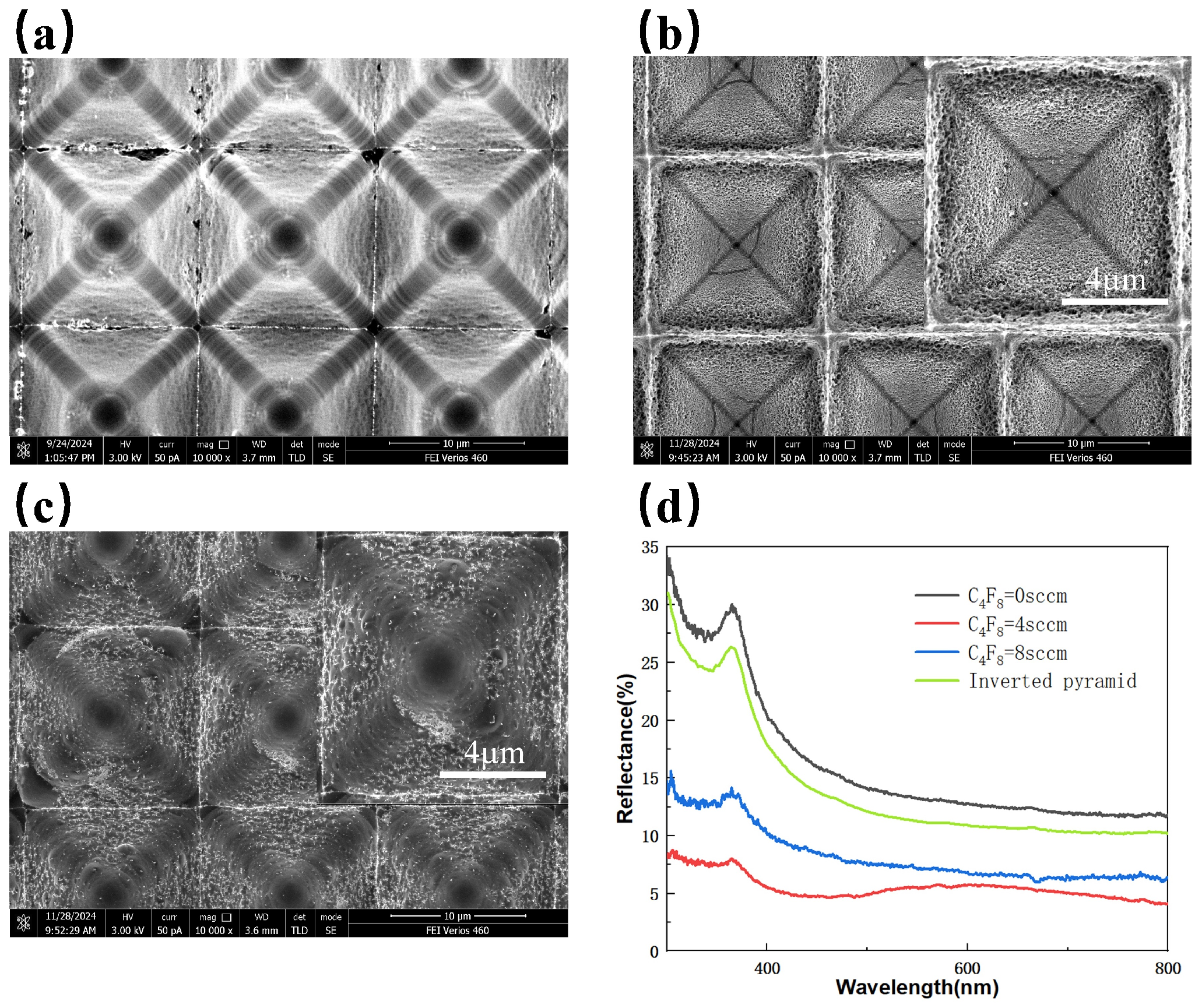

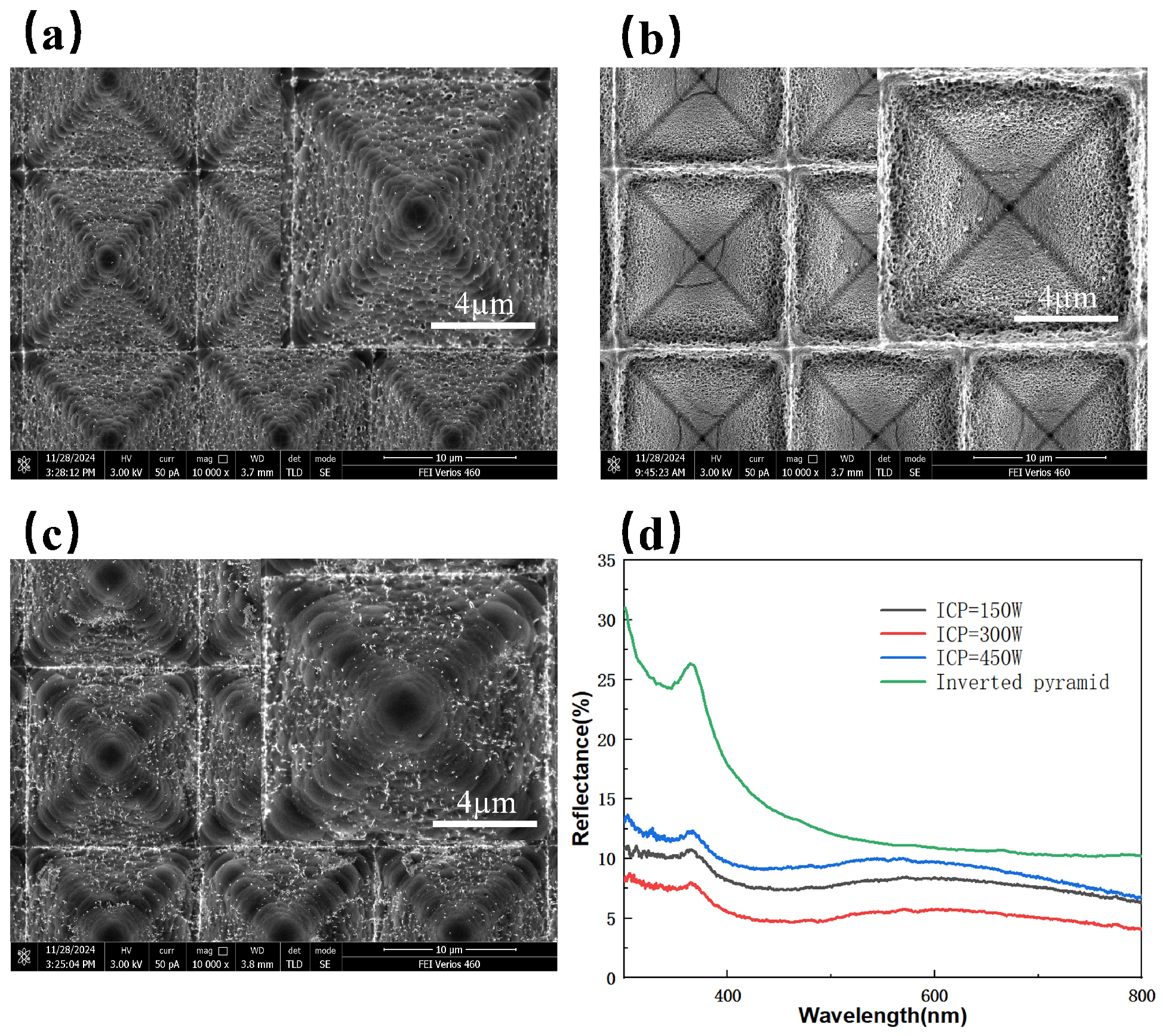
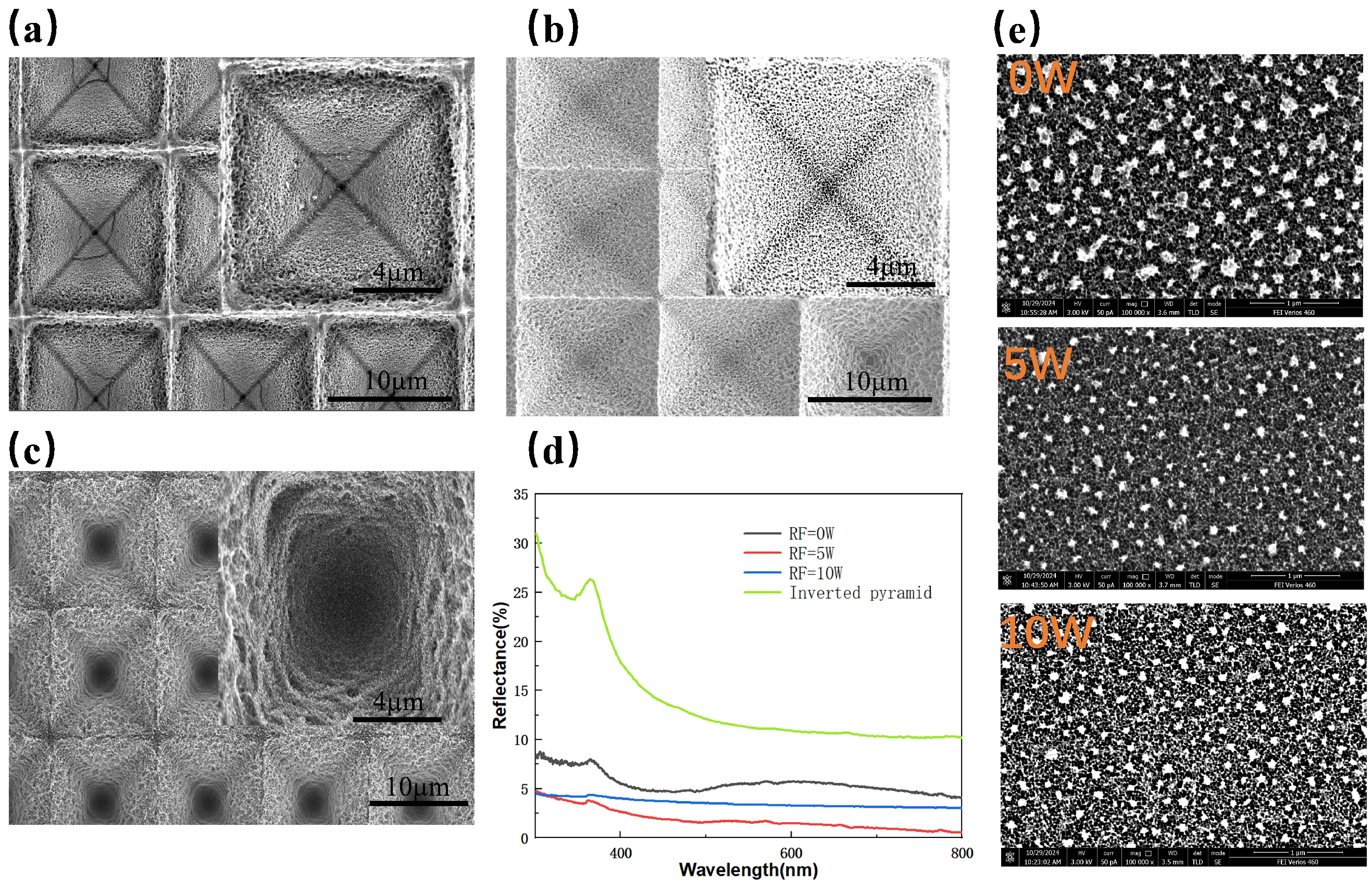


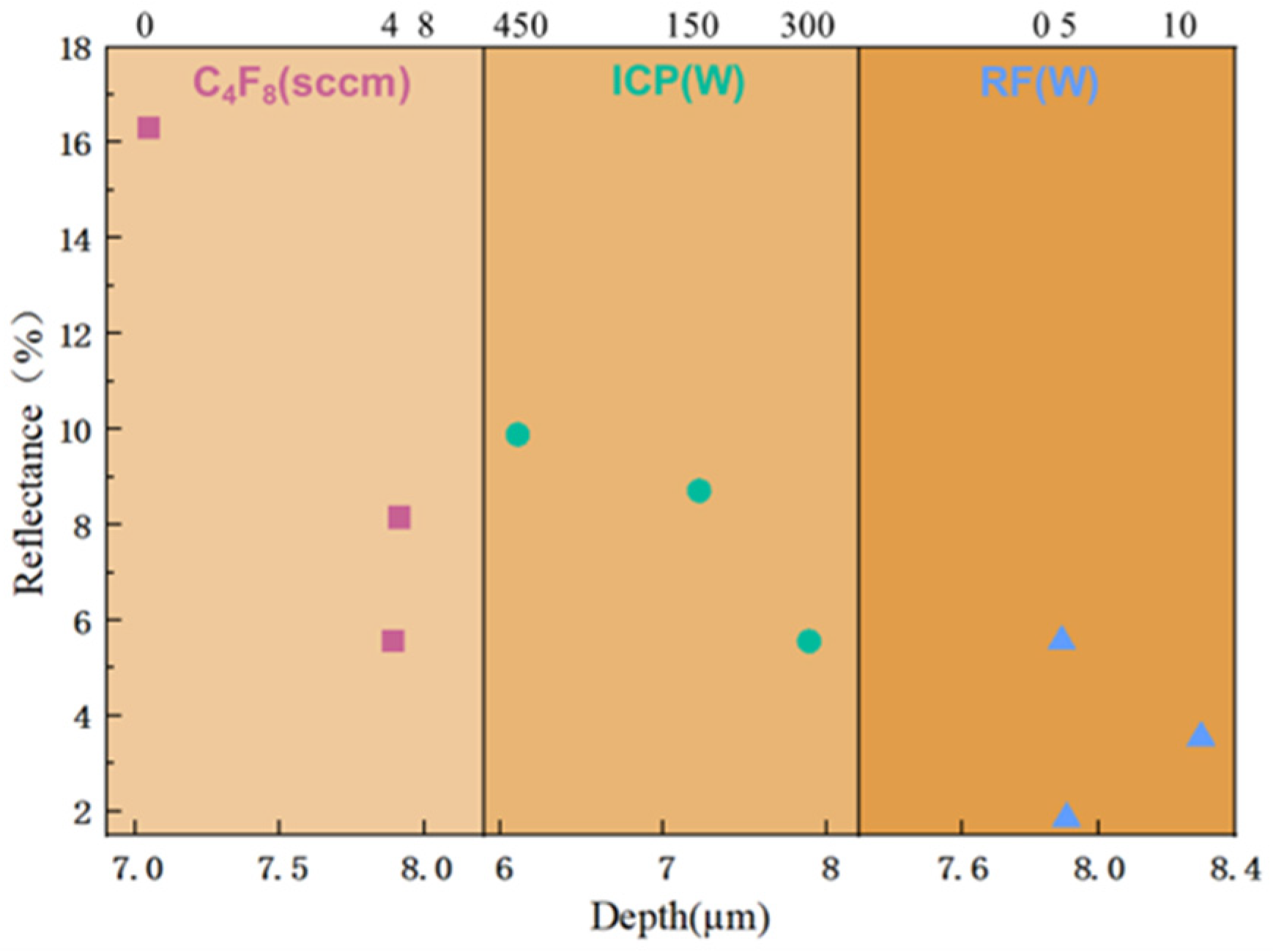
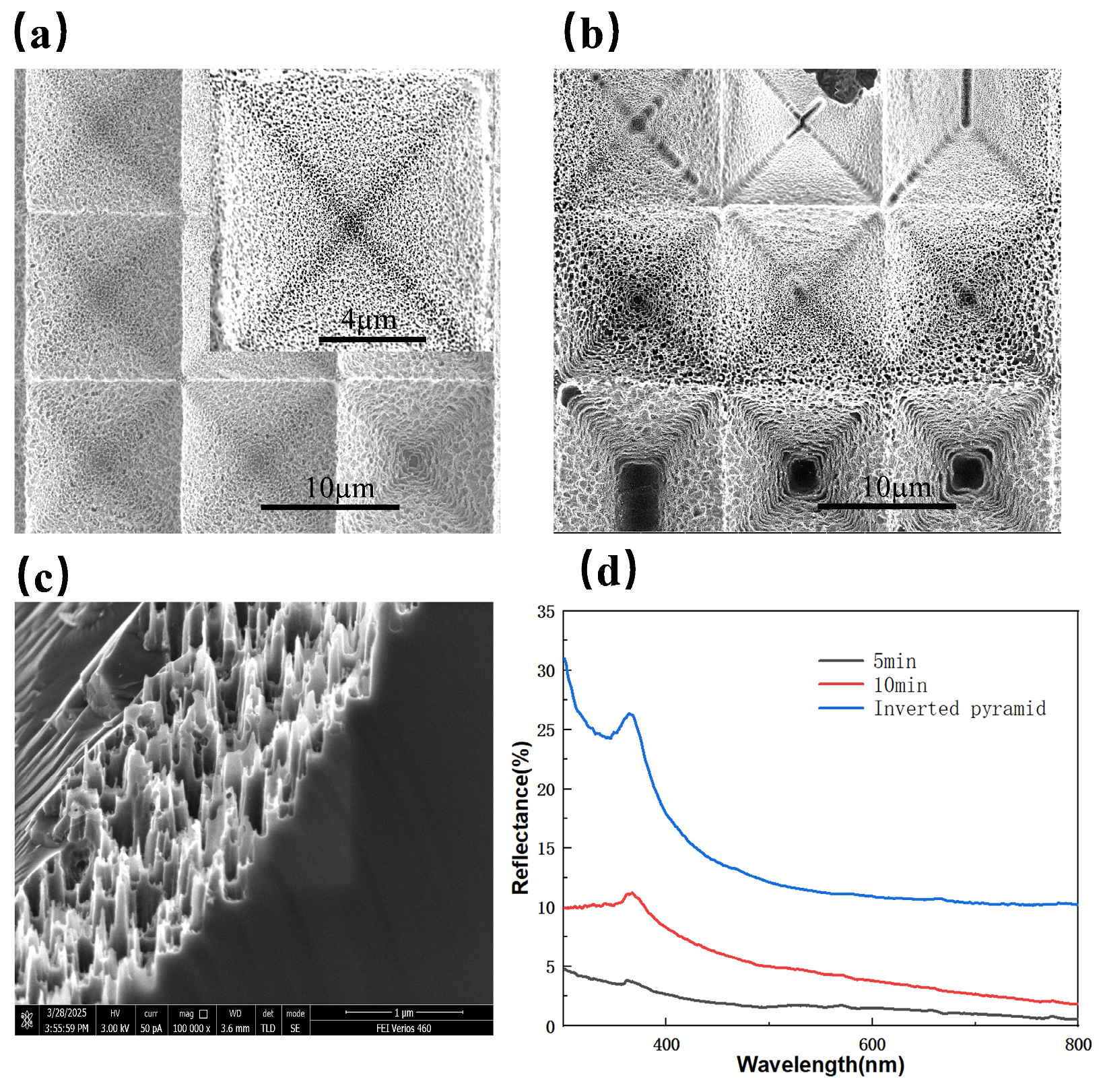
| Sample | SF6:O2 (sccm) | C4F8 (sccm) | ICP (W) | RF (W) | Time (min) | Average Reflectance 300–800 nm (%) |
|---|---|---|---|---|---|---|
| 0 | 0 | 0 | 0 | 0 | 0 | 13.85 |
| 1 | 18:3 | 0 | 300 | 0 | 5 | / |
| 2 | 18:6 | 0 | 300 | 0 | 5 | / |
| 3 | 18:9 | 0 | 300 | 0 | 5 | 16.3 |
| 4 | 18:12 | 0 | 300 | 0 | 5 | / |
| 5 | 18:15 | 0 | 300 | 0 | 5 | / |
| 6 | 18:18 | 0 | 300 | 0 | 5 | / |
| 7 | 18:9 | 4 | 300 | 0 | 5 | 5.56 |
| 8 | 18:9 | 8 | 300 | 0 | 5 | 8.15 |
| 9 | 18:9 | 4 | 150 | 0 | 5 | 8.71 |
| 10 | 18:9 | 4 | 450 | 0 | 5 | 9.89 |
| 11 | 18:9 | 4 | 300 | 5 | 5 | 1.86 |
| 12 | 18:9 | 4 | 300 | 10 | 5 | 3.55 |
| 13 | 18:9 | 4 | 300 | 5 | 10 | 5.24 |
Disclaimer/Publisher’s Note: The statements, opinions and data contained in all publications are solely those of the individual author(s) and contributor(s) and not of MDPI and/or the editor(s). MDPI and/or the editor(s) disclaim responsibility for any injury to people or property resulting from any ideas, methods, instructions or products referred to in the content. |
© 2025 by the authors. Licensee MDPI, Basel, Switzerland. This article is an open access article distributed under the terms and conditions of the Creative Commons Attribution (CC BY) license (https://creativecommons.org/licenses/by/4.0/).
Share and Cite
Fan, Z.; Xu, L.; Zhou, B.; Chen, T. Fabrication of Anti-Reflective Composite Structures on Inverted Pyramids Using Inductively Coupled Plasma Etching. Micromachines 2025, 16, 503. https://doi.org/10.3390/mi16050503
Fan Z, Xu L, Zhou B, Chen T. Fabrication of Anti-Reflective Composite Structures on Inverted Pyramids Using Inductively Coupled Plasma Etching. Micromachines. 2025; 16(5):503. https://doi.org/10.3390/mi16050503
Chicago/Turabian StyleFan, Zhiwei, Liang Xu, Biyun Zhou, and Tao Chen. 2025. "Fabrication of Anti-Reflective Composite Structures on Inverted Pyramids Using Inductively Coupled Plasma Etching" Micromachines 16, no. 5: 503. https://doi.org/10.3390/mi16050503
APA StyleFan, Z., Xu, L., Zhou, B., & Chen, T. (2025). Fabrication of Anti-Reflective Composite Structures on Inverted Pyramids Using Inductively Coupled Plasma Etching. Micromachines, 16(5), 503. https://doi.org/10.3390/mi16050503





